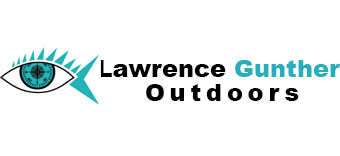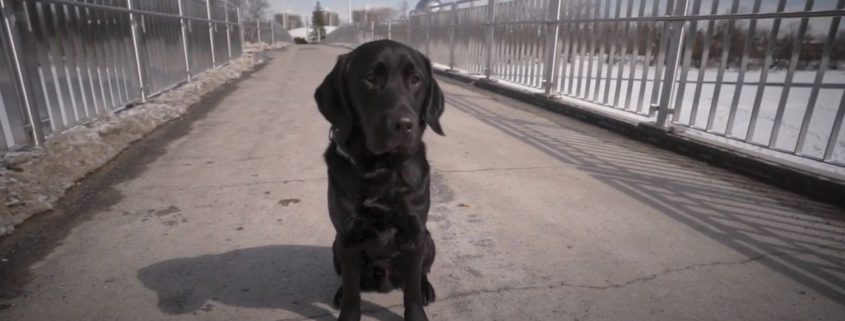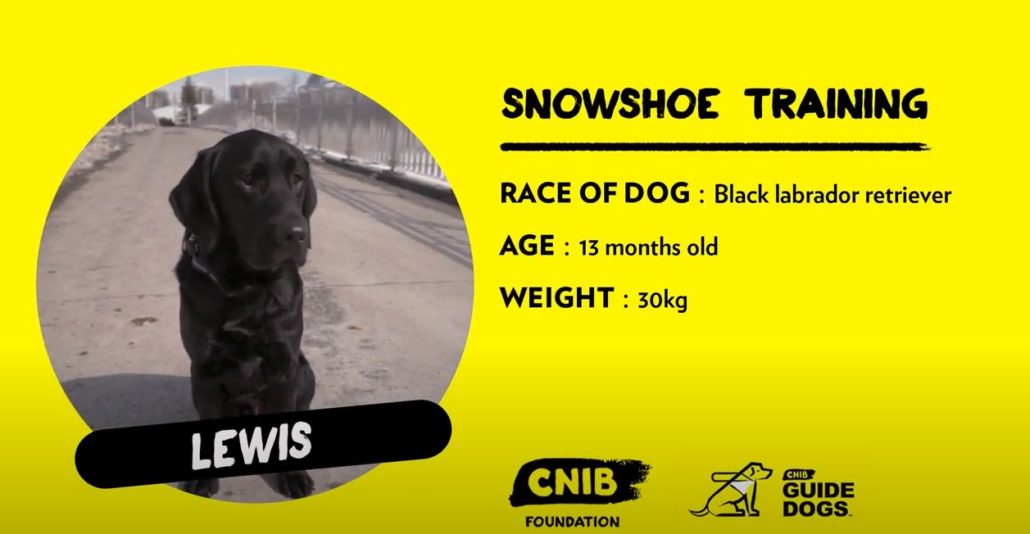Episode 3: Snowshoeing and Sledding ‒ Part 2: Snow Shoeing
After working up quite a sweat sledding in the morning, we now had an afternoon of snow shoeing to look forward to. Same two dogs, Sherman and Lewis, but this time it’s my wife, Anne who joined me while Theo took a well-earned rest.
Andrew and Karen met us at a near-by forest with Sherman and Lewis warmed up and ready to go. Our mission was to introduce the dogs to snow shoeing. In case you might be wondering, they won’t be wearing the snowshoes, just Anne and Me.
Both Sherman and Lewis did very well at this much slower outdoor winter activity. It didn’t mean it was easier though as it meant they had to walk in deep snow. Sherman demonstrated a bit more independence on where he wanted to go while I held his leash, but that’s only because he hardly knows me. Lewis on the other hand seemed quite observant on what I was doing and maintained his position well as we undertook the circuit. I think they both did just fine for a first attempt.
I only found out later that Andrew and Karen were wondering the entire time if I was a bit bonkers for doing this. But, like I explained, this is something I’ve been doing with dogs that goes back to when I was young and could still see, even though I was assessed as legally blind at age eight. I just enjoy snow shoeing and I find it easier if you can let the dogs run free, but this is not always allowed or advisable.
Snowshoes are meant for walking on the surface of deep snow. Without the shoes, your feet sink into the snow and any progress harder and slower. They are a great and ancient indigenous technology for humans, but what about the dogs? Where are they expected to walk?
Since for obvious reasons I’m never the one breaking the trail, I’m always the one who gets to walk in the footprints of the person in front. I follow the leader by attaching a small bell to the back of their parka. It means a lot less verbal communication about the walk itself, and more time freed up for your sighted guide to look around and describe the area. They will still need to warn you of low hanging branches, or a steep climb or descent, or some sort of obstacle and how best to pass by it. The problem with this technique is that I never know exactly how closely I’m following even though I need to follow close enough to stay in their tracks.
Longer distances between the person in front wearing the bell and my position on the trail means that I might not notice when the bell-wearing leader has taken a sharp turn. My moving directly towards the sound could have me cutting off the trail itself and directly into an obstacle like a tree or rock or stump.
Getting too close to the leader with the bell results in stepping on the back of Anne’s snowshoes and causing her to lose balance, or stumble and fall. Trust me! No one enjoys having their snowshoes stepped on by the person following behind. Do this too many times, and you’re not likely to be invited back.
So where does the dog go? Do they stay between the leader and me on the trail and run the risk of having their leg stepped on by a snowshoe, or stepping on the back of the leader’s snowshoe? Neither are good ideas. For this reason, I encourage the dog to either stay to my side or walk behind if the snow is too deep and they become fatigued.
Dogs that are in reasonably good condition have no problem walking through deeper snow. They may not like it, but they can do it. Given that no harness-guiding work is involved with any of this, it’s not a problem if the dog is out to my side or following behind me. But, since many official trails require that dogs stay on leashes, be sure that your leash is at least two meters in length so your dog can easily stay far enough away from you to avoid stepping on your snowshoes.
Regarding the use of hiking poles, I only use one. Not using a pole in the hand holding the leash means the chance of my accidently poking my dog is minimal. I use it in the hand that is not holding the dog leash.
The pole performs multiple purposes. It helps with my identifying what’s on the ground in front of me. However, you don’t want to be swinging your pole around because they have pointy tips that can cause the dog injury. You can also use the pole as a way of connecting directly with the person in front of you, should the trail become more technical or difficult. You simply ask the person ahead to grasp the tip of your pole as you continue to hold the handle. This allows you to follow at the perfect distance while feeling exactly when the guide is ascending or descending steep areas of the trail or stepping over obstacles like large rocks or fallen trees.
A pole can also be used for training the dog not to walk in front of you or too closely behind. By gently sweeping the pole across the path in front or behind you, being sure to keep the tip close to the ground, you can nicely warn the dog away. I know, normally you want your dog by your side, which is how they are trained, but trust me, it doesn’t take long for the dog to understand that a bit of distance is a good thing.
So, many of you may be asking why bring your guide dog snowshoeing? There are many reasons. First, the dog gets some exercise. Second, the dog will always be wearing its harness, which means moving between vehicles and the start and end of paths when snowshoes are removed can be accomplished more independently. And last, should it be necessary for you to find your way back to the trail or the beginning or end of the path on your own should your sighted guide become injured, you will stand a greater chance of doing so successfully since the dog can then lead you by staying well ahead of you on the path while still on the long leash looped around your wrist.
It’s a good idea to practice taking the lead on well groomed trails so your dog can get use to lightly guiding you on snowshoe trails using the leash alone. Trainers don’t like you doing this, but as long as you never correct your dog if you bump into an obstacle when holding the leash only, and not the harness, than the dog and you will get along fine. The dog will feel bad when you do fall or bump something, but as long as you let the dog know it’s not their fault, because you weren’t holding their harness at the time, no serious undermining of their training will result. Just remember that there always needs to be some tension in the leash so you know the dog is staying well ahead the tips of your snow shoes. If the leash goes slack, stop, until the dog gets moving again.
It turned out to be a perfect walk for the dogs’ first time. Sure, they would rather walk on well compacted trails or sidewalks, but once they get in the spirit, they love the challenge. Besides, it’s not like I’m moving along at any great speed. The pace is more than adequate to make sure the dogs never experience fatigue.
Both Lewis and Sherman were real troopers. They loved being in the forest. Without leaves in the trees or thick underbrush to reduce their range of sight, the forest in winter really opens things up at dog level. The snow on the evergreen trees also absorbs a lot of sound so a forest in winter becomes a place of tremendous silence. This means you can’t count on audible indicators like rushing rivers or near-by roads to provide clues about where you are if you’re breaking new trails. I know from experience that getting lost in the forest in winter can be exhausting, scary, and cold. Best to stay on established trails.




